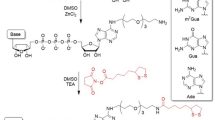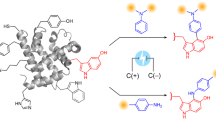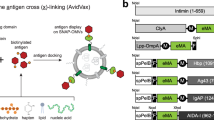Abstract
We provide a detailed protocol for designing water-soluble CdSe–ZnS quantum dots (QDs) based on cap exchange of the native hydrophobic shell with dihydrolipoic acid (DHLA) ligands, and the preparation of functional QD bioconjugates for use in immunoassays. Our conjugation strategy is based on non-covalent self-assembly between DHLA-capped QDs and protein appended with either an electrostatic attachment domain (namely, the basic leucine zipper) or a polyhistidine tag. These bioconjugates combine the properties of the QD and attached biomolecule to create structures with desirable luminescent and biologically specific properties. This method also allows the preparation of mixed surface conjugates, which results in the conjugates gaining multiple biological activities. Conjugation of DHLA-capped QDs to maltose binding protein (MBP), the immunoglobulin-G-binding β2 domain of streptococcal protein G (PG) and avidin will be described. MBP and PG were modified by genetic fusion with either a charged leucine zipper or a polyhistidine interaction domain.
*Note: In the version of this article initially published online, the article’s page numbers should have been 1258–1266. This error has been corrected in the PDF version of the article.
This is a preview of subscription content, access via your institution
Access options
Subscribe to this journal
Receive 12 print issues and online access
$259.00 per year
only $21.58 per issue
Buy this article
- Purchase on Springer Link
- Instant access to full article PDF
Prices may be subject to local taxes which are calculated during checkout



Similar content being viewed by others
Change history
30 November 2006
In the version of this article initially published online, the article’s page numbers should have been 1258–1266. This error has been corrected in the PDF version of the article.
References
Gaponenko, S.V. Optical Properties of Semiconductor Nanocrystals (Cambridge University Press Cambridge, UK, 1998).
Michalet, X. et al. Quantum dots for live cells, in vivo imaging, and diagnostics. Science 307, 538–544 (2005).
Medintz, I.L., Uyeda, H.T., Goldman, E.R. & Mattoussi, H. Quantum dot bioconjugates for imaging, labeling and sensing. Nature Materials 4, 435–446 (2005).
Dubertret, B. et al. In vivo imaging of quantum dots encapsulated in phospholipid micelles. Science 298, 1759–1762 (2002).
Wu, X.Y. et al. Immunofluorescent labeling of cancer marker Her2 and other cellular targets with semiconductor quantum dots. Nature Biotech. 21, 41–46 (2003).
Mattoussi, H. et al. Self-assembly of CdSe-ZnS quantum dot bioconjugates using an engineered recombinant protein. J. Am. Chem. Soc. 122, 12142–12150 (2000).
Kim, S. & Bawendi, M.G. Oligomeric ligands for luminescent and stable nanocrystal quantum dots. J. Am. Chem. Soc. 125, 14652–14653 (2003).
Goldman, E.R. et al. Conjugation of luminescent quantum dots with antibodies using an engineered adaptor protein to provide new reagents for fluoroimmunoassays. Anal. Chem. 74, 841–847 (2002).
Goldman, E.R. et al. Avidin: a natural bridge for quantum dot-antibody conjugates. J. Am. Chem. Soc. 124, 6378–6382 (2002).
Murray, C.B., Norris, D.J. & Bawendi, M.G. Synthesis and characterization of nearly monodisperse CdE (E = sulfur, selenium, tellurium) semiconductor nanocrystallites. J. Am. Chem. Soc. 115, 8706–8715 (1993).
Peng, Z.A. & Peng, X. Formation of high-quality CdTe, CdSe, and CdS nanocrystals using CdO as precursor. J. Am. Chem. Soc. 123, 183–184 (2001).
Hines, M.A. & Guyot-Sionnest, P. Synthesis and characterization of strongly luminescing ZnS-capped CdSe nanocrystals. J. Phys. Chem. 100, 468–471 (1996).
Dabbousi, B.O. et al. CdSe-ZnS core-shell quantum dots: synthesis and characterization of a size series of highly luminescent materials. J. Phys. Chem. B 101, 9463–9475 (1997).
Peng, X., Schlamp, M.C., Kadavanich, A.V. & Alivisatos, A.P. Epitaxial growth of highly luminescent CdSe/CdS core/shell nanocrystals with photostability and electronic accessibility. J. Am. Chem. Soc. 119, 7019–7029 (1997).
Medintz, I.L. et al. Self-assembled nanoscale biosensors based on quantum dot FRET donors. Nature Mat. 2, 630–638 (2003).
Clapp, A.R. et al. Fluorescence resonance energy transfer between quantum dot donors and dye-labeled protein acceptors. J. Am. Chem. Soc. 126, 301–310 (2004).
Goldman, E.R. et al. Self-assembled luminescent CdSe-ZnS quantum dot bioconjugates prepared using engineered poly-histidine terminated proteins. Anal. Chim. Acta 534, 63–67 (2005).
Goldman, E.R. et al. A hybrid quantum dot-antibody fragment fluorescence resonance energy transfer-based TNT sensor. J. Am. Chem. Soc. 127, 6744–6751 (2005).
Lakowicz, J.R. Principles of Fluorescence Spectroscopy 2nd edn (Kluwer Academic/Plenum Publishers, New York, 1999).
Goldman, E.R., Mattoussi, H., Anderson, G.P., Medintz, I.L. & Mauro, J.M. in Methods in Molecular Biology Vol. 303: NanoBiotechnology Protocols (eds. Rosenthal, S.J. & Wright, D.W.) 19–33 (Humana Press Inc., Totowa, NJ, 2005).
Chang, H.C. et al. A general method for facilitating heterodimeric pairing between 2 proteins — applications to expression of α and β-T-cell receptor extracellular segments. Proc. Natl. Acad. Sci. USA 91, 11408–11412 (1994).
Goldman, E.R. et al. 2,4,6-trinitrotoluene detection using recombinant antibodies. J. Environ. Monit. 5, 380–383 (2003).
Gunsalus, I.C., Barton, L.S. & Gruber, W. Biosynthesis and structure of lipoic acid derivatives. J. Am. Chem. Soc. 78, 1763–1768 (1956).
Goldman, E.R. et al. Multiplexed toxin analysis using four colors of quantum dot fluororeagents. Anal. Chem. 76, 684–688 (2004).
Acknowledgements
This work was supported by grants from the Office of Naval Research (ONR) and DARPA. A.R.C. was supported by a National Research Council fellowship.
Author information
Authors and Affiliations
Corresponding author
Ethics declarations
Competing interests
The authors declare no competing financial interests.
Rights and permissions
About this article
Cite this article
Clapp, A., Goldman, E. & Mattoussi, H. Capping of CdSe–ZnS quantum dots with DHLA and subsequent conjugation with proteins. Nat Protoc 1, 1258–1266 (2006). https://doi.org/10.1038/nprot.2006.184
Published:
Issue Date:
DOI: https://doi.org/10.1038/nprot.2006.184
This article is cited by
-
Quantum dots based in-vitro co-culture cancer model for identification of rare cancer cell heterogeneity
Scientific Reports (2022)
-
Quantum dots in proteomic studies and medical diagnostics
Russian Chemical Bulletin (2018)
-
A Rapid Detection Method of Brucella with Quantum Dots and Magnetic Beads Conjugated with Different Polyclonal Antibodies
Nanoscale Research Letters (2017)
-
Quantum dot assisted tracking of the intracellular protein Cyclin E in Xenopus laevis embryos
Journal of Nanobiotechnology (2015)
-
Anodic Electrogenerated Chemiluminescence of Ru(bpy)32+ with CdSe Quantum Dots as Coreactant and Its Application in Quantitative Detection of DNA
Scientific Reports (2015)
Comments
By submitting a comment you agree to abide by our Terms and Community Guidelines. If you find something abusive or that does not comply with our terms or guidelines please flag it as inappropriate.



